HERITAGE WEEK 2021
In 1985, the Ontario government designated
the third week in February as Ontario Heritage Week,
with the federal Heritage Day kicking off the week.
In 1985, the Ontario government designated
the third week in February as Ontario Heritage Week,
with the federal Heritage Day kicking off the week.
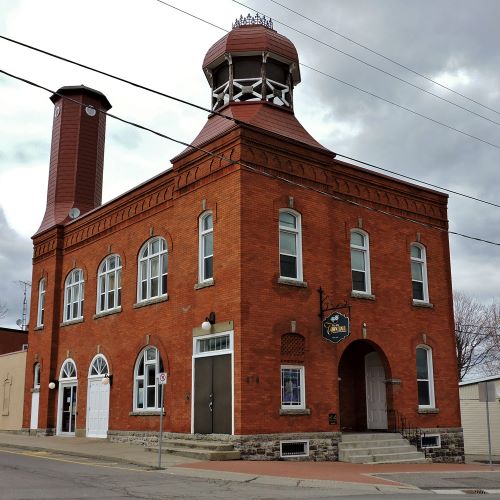
Built in 1904 for $5,000, the Old Town Hall (Winchester Cultural Centre) located at 478 Main Street East in Winchester has gone through many changes. From 1906 to 1961, it was the village library. During the 1920’s, it showcased movies, plays, and concerts with local dances held upstairs. For 65 years, the Old Town Hall acted as Winchester’s local jail, and visitors can still see evidence of jail cells in the form of bars on windows and original cell doors. From 1970 to 1980, the Ontario Provincial Police made their headquarters there.
Now, the Old Town Hall is home to the Dundas County Players theatre group, who have been entertaining the community with plays, cabarets, and dinner theatre since 1996. True to its history of versatility. The Old Town Hall doesn’t just serve this one purpose. It also hosts “A Night at the Movies”, as well as Open Mic Night on a regular basis. The Old Town Hall has been host to many other community events like concerts (including the Festival of Small Halls, as well as artists Dan Hill and Sean McCann), live entertainment, book and CD release parties, and weddings.
For many newcomers to the area, it was not possible to buy land outright, and so renting, or leasing, was the preferred option. This is a Lease between the Canada Company and Richard Ennis of Elizabethtown, dated April 18, 1843. Ennis was agreeing to rent the east half of lot 21 in the 1st Concession of Mountain Township, consisting of 100 acres. The lease for a term of 10 years, at a rent of £3.10.6 a year. It was a fairly normal Agreement, but an official of the Company has added some advice in writing in the margins of the document.
First, on the side, they give instructions on how to execute the document:
“Fill in your place of Residence. Execute in presence of a Justice of the Peace and another Witness and attend to the Printed Notice at foot.”
The notice at the bottom of the page is a very direct warning about what would happen if the rent was ever in arrears:
“You are most earnestly requested before Signing this Instrument seriously to consider whether you can pay the Rents punctually on the 1st February in each year, without reference to date of Lease, for if you do not pay and perform the other Covenants your Lease will immediately be absolutely forfeited, the Land open to any new occupant and advertised accordingly, and you will then lose all your Improvements.”
Everything, for Richard Ennis, would depend on how well he could work the land, raise his crops, and find a good price for them at market. Any serious problems would result in him losing, not only the land itself, but any buildings he had erected, such as his home, or barns. Life in North Dundas in 1843 was uncertain and settlers risked everything to put down roots in their new homes. These are the people who founded North Dundas.
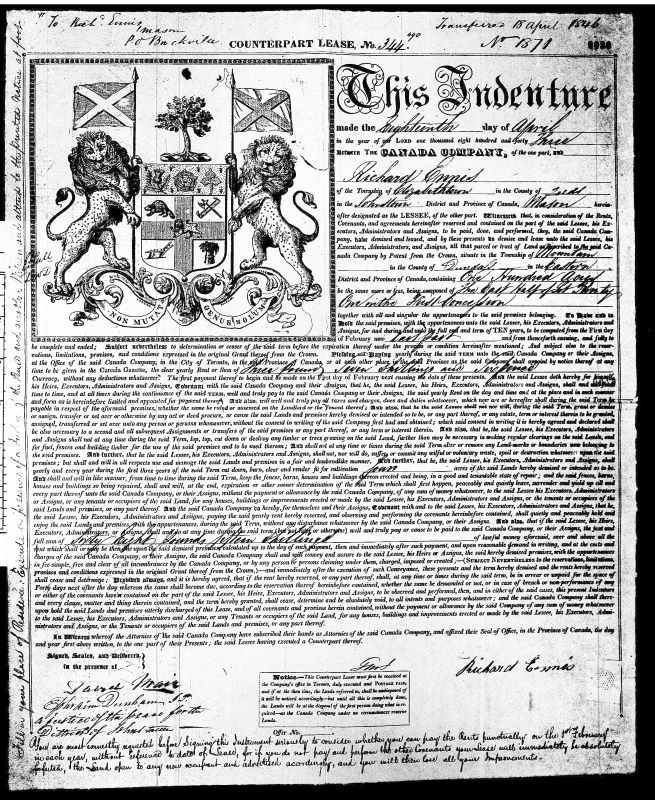
Mitchell’s Canada Gazetteer and Business Directory,
1864 & 1865 listed many of the towns, villages and hamlets in the country,
giving statistics on population and businesses in each one.
HALLVILLE
A village in Mountain Township, Dundas County, Ontario 60 miles northwest of Cornwall, the county seat, 7 miles northeast of Kemptville the nearest banking point, and 2 miles from Mountain on the C P R its nearest shipping point. It contains Methodist and Presbyterian churches and a public school. Stage to Mountain daily. Population, 150.
W T Clelland was the Postmaster and he operated out of one of two General Stores, the other run by D. Finkelstein. The Shaw & Dougall saw mill was a major employer in the village, other factories produced potash and pumps. Robert Hyndman was in business as a grain merchant. There were two blacksmiths, B. Adams and William Patterson, as well as Joseph Thompson’s carriage making business. There were the usual businesses of the time: a tailor, two carpenter, two shoemakers, and two dressmakers.
SOUTH MOUNTAIN
A village in Mountain Township, Dundas County, Ontario 50 miles northwest of Cornwall, the county seat, 15 miles north of Iroquois, and 3 miles south of Mountain on the C P R, its nearest railway point. Nearest bank at Winchester. It contains Catholic, Anglican, Presbyterian and Methodist churches and a public school. Stages daily to Iroquois and Mountain. Population, 400.
South Mountain was quite a busy place in 1865. Nelson Bowen had a hotel, as did Eli Montgomery, which implies a lot of travellers passing through regularly. George Stacey was the Postmaster and local doctor too. The Clelands operated a grocery store, and David Cleland was also a carriage maker, while M.J. Cleland was a Clerk in the Division Court. Perhaps this was the same family who ran the Post Office and store in Hallville. There were five stores in the village, as well as the usual painters, tailors, two blacksmiths, shoemakers, and butchers.
Some specialised trades operated in South Mountain in 1865. William Bailey was a tinmaker, Robert Boyd made stoves, Henry Moore operated a tannery, Robert Walker had a brick making factory, and there was a cheese factory owned by J. Soper. More unusual were the two cabinet makers, Elijah Gregory and D. Hunter.
All in all, South Mountain was a hive of activity in the 1860’s.
CHESTERVILLE
A post village in Dundas County, Ontario, on the Nation River, and a station on the C.P.R. It contains 5 churches (Methodist, Presbyterian, Episcopal, Roman Catholic and Hornerite), 9 stores, 2 hotels, 1 saw and grist mill, 1 sash and door factory, 2 branch banks, and 1 printing office issuing a weekly newspaper. Population 900.
by David Shanahan
A piece of legislation was passed by the Ontario Government on April 7, 1890, changing the name of the Village of West Winchester. The municipal corporation had petitioned the Legislative Assembly for the name change, for a number of reasons. When the village was first established, the Post Office, then a central point of business and commerce, was located at a settlement “a few miles to the east called Winchester, but which has since been changed to Chesterville”.
Hence West Winchester was named. But complications had arisen since Chesterville had changed its name. The Canadian Pacific Railway station in West Winchester was called simply “Winchester”. The municipal corporation considered West Winchester was too long a name, “and has no local or geographical signification”.
So, in order to clarify the situation, the Assembly passed An Act to change the name of the Village of West Winchester, to that of Winchester, making everyone happy once more.
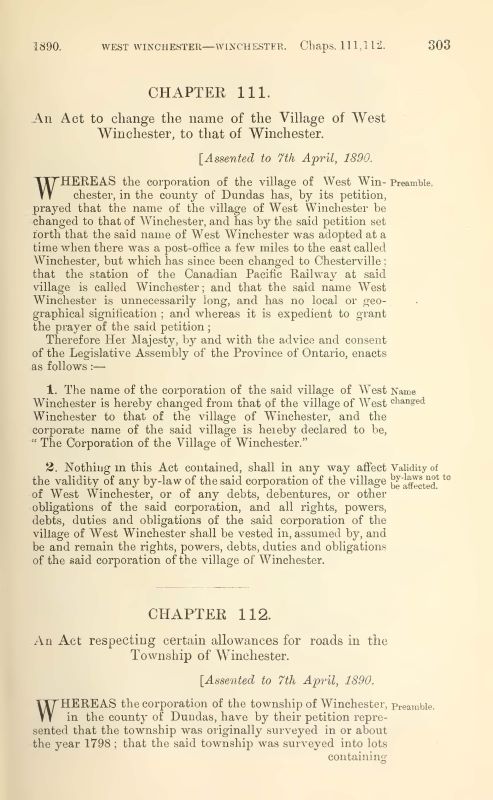
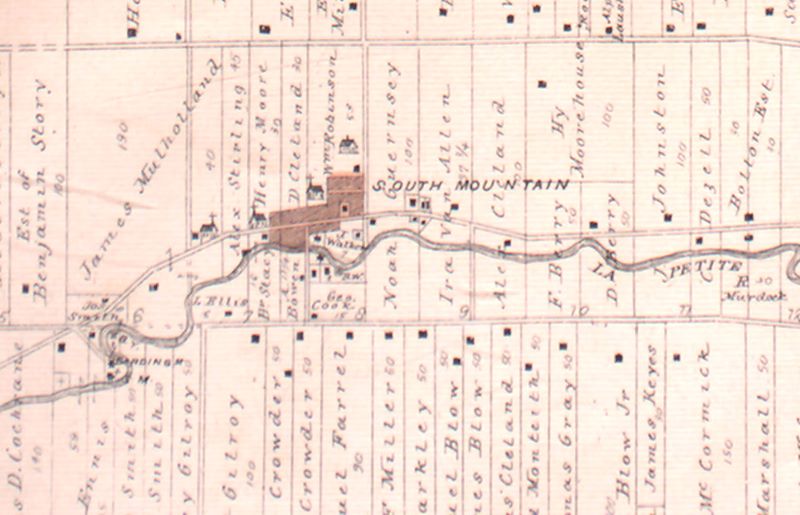
by David Shanahan
In 1833, the leading residents of Mountain Township petitioned the Executive Council of Upper Canada to have survey work done in their township. It seems that when the original survey was performed, the Concession lines of the 10th, 11th, and 12th Concessions were either not laid out properly, or the surveyor’s markers had disappeared. This caused confusion and possible disagreement about where the boundaries of farm lots were actually situated.
The Petition was signed by William Cleland, Henry Loughlin, John Allen, Joseph Clark, Joseph Clark, jnr., John McGahey, Bernard McGahey, Lawrence Fitzpatrick, Andrew Fitzpatrick, John Gaffney, George Gibson, Alexander Clark, Hezekiah Clark, John Loughlin, John McCluskey, and Michael Loughlin.
They asked that John West, Provincial Land Surveyor, be used for the job. On inspection, it was reported that two of the lines had been run, but not that of the 10th Concession. The Executive Council ordered that the work be done, and William Cleland was informed of this decision on April 24, 1833.
The British Empire went to war in South Africa in 1899 in an imperial venture to take control of minerals and territory. Opposed by the Boers, descendants of earlier Dutch settlers, Britain put pressure on Canada to send troops, although Canadians had never served outside of the homeland before. Canada was divided over the prospect, and Prime Minister Laurier compromised by agreeing to pay for a volunteer corp to join the war.
7,368 Canadian volunteers and 12 nursing sisters were eventually to serve in South Africa, of whom 89 were killed or died of wounds. Some 252 were wounded, 135 more died by accident and disease. The Canadian War Museum records that “Canadian troops burned Boer houses and farms, and moved civilians to internment camps. In these filthy camps, an estimated 28,000 prisoners died of disease, most of them women, children, and black workers. Civilian deaths provoked outrage in Britain and in Canada”.
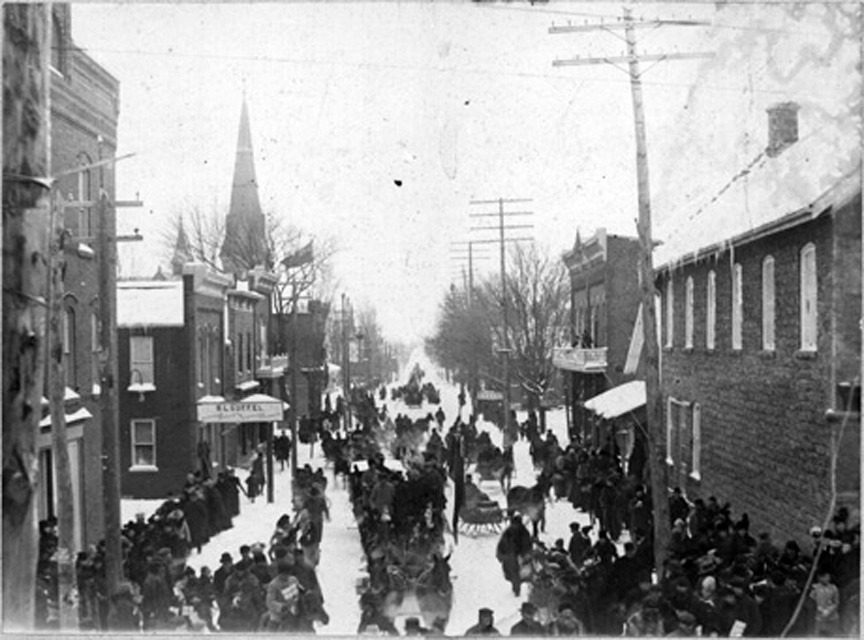
by David Shanahan
During the emergency following the great Ice Storm in January, 1998, volunteer workers came from around the province to help with repairs, clean-up and other assorted jobs. The new township of North Dundas had agreed to feed these volunteers, and authorised them to go to a local restaurant for meals. All was fine until the bills arrived from the restaurants for payment.
One bill, for example, totaled more than $400, which may not seem much these days. The problem was that the items on the tab included 40 beers, 26 doubles, 12 Crown Royals, and 17 tequilas. Councillor Keith Fawcett pointed out that: “I don’t mind paying for their food, but I am concerned about the drinking”. Mayor Claude Cousineau was concerned about the safety issue when those men went back to work.
The final total for the meals amounted to between $300 and $400 for alcohol alone, and the Council felt they had no choice but to pay up. But they considered taking legal opinion on the matter. In the end, it was accepted that, if the volunteers had been paid for the work they did, it would have cost the township far more than the meals and drinks.
That was no consolation when the bills came in for township staff and fire fighters. Taking overtime pay into account, the ice storm had cost the township around half a million dollars in wages. To make matters worse, council were told that the $400,000 which had been borrowed by the township to cover expenses during the emergency was almost all gone, with only $55,000 left. That seemed acceptable, until it was then reported that there were still accounts yet to arrive from the various wards of at least $85,000. It was not a good way for the newly-established Township of North Dundas to begin operations.
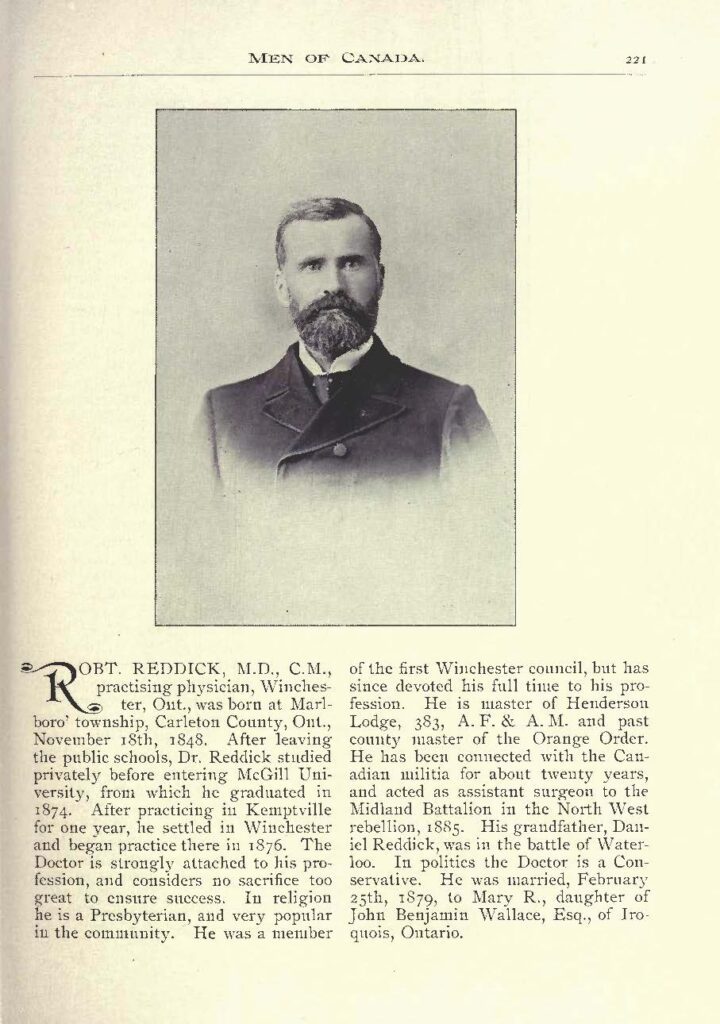
This entry is taken from a fascinating book published in 1893, with the lengthy title: “The Canadian Album. Men of Canada; or Success by Example in Religion, Patriotism, Business, Law, Medicine, Education and Agriculture”. This was Volume 2 of the work, and consisted of 500 pages of short biographies of men, all men, from Quebec and Eastern Ontario. This entry provides an insight into the professionals living in North Dundas at the end of the Nineteenth Century.